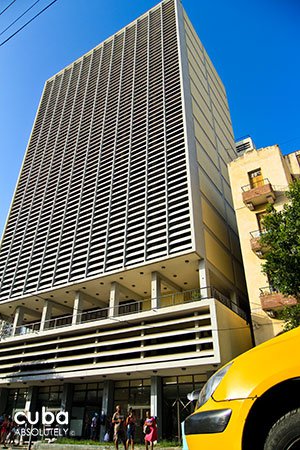In 1953, architect Antonio Quintana won the competition for the design of a building which would house doctors’ offices, stores and other public spaces. The use of brise-soleil, popularized by the French architect Le Corbusier and readily assimilated by Cuban architects and from other countries in the Americas, especially, Brazil, given its practical applicability in tropical climates for both shading and ventilation purposes, is an outstanding feature of this building. The brise-soleil here also offers an aesthetically pleasing appearance, which some experts claim was influenced by the skyscraper project designed by Le Corbusier for Algiers. The vestibule features El dolor humano, a mural painting by the Cuban painter Mariano Rodríguez. Today, the building is home to the Faculty of Economics of the University of Havana, as well as the Talía Theatre and the L Art Gallery, the latter two on the ground floor. The building was awarded Gold Medal by the National School of Architects in 1956.

Convento e Iglesia de Nuestra Señora de Belén LH  4
4
Made up of a church, a convent and a peculiar vaulted arch, this religious complex is the most extensive of those surviving in Old Havana. After the arrival in Havana of the first members of the Order …
 BaroqueAdmission: FreeOpen: 8am-6pm Mon-FriCompostela e/ Luz y Acosta, Habana Vieja
BaroqueAdmission: FreeOpen: 8am-6pm Mon-FriCompostela e/ Luz y Acosta, Habana Vieja 
Monumento a José Miguel Gómez LH  4
4
Located on Avenida de los Presidentes, this is one of the most lavish monuments in the city. Its bas-reliefs show important moments in the life of José Miguel Gómez, president of the Republic of Cuba …

Avenida Paseo LH  4
4
Avenida Paseo, with large trees on both sides and a wide promenade with topiary and benches, is one of Havana’s most classy streets. There are luxurious mansions on both sides of the street, including …

Palacio Cueto LH  4
4
Rising over the plaza off the southeast corner is Palacio Cueto. Built in 1906 with an elaborately adorned façade featuring griffins, satyrs and other mythical figures, it’s reminiscent of the moderni …
 Art NouveauMercaderes esq. a San Ignacio, Habana Vieja
Art NouveauMercaderes esq. a San Ignacio, Habana Vieja 
Lonja del Comercio LH  4
4
The Lonja del Comercio, which first opened on March 1909, is angled obliquely to the square on its northern side. It was built in eclectic-style by the architectural firm of Purdy and Henderson as a c …
 EclecticOpen: 9am-5pm Mon-SunLamparilla, esq. a Oficios, Habana Vieja
EclecticOpen: 9am-5pm Mon-SunLamparilla, esq. a Oficios, Habana Vieja 
Seminario San Carlos y San Ambrosio (Real y Conciliar Colegio Seminario de San Carlos) LH  4
4
In 1689, Bishop Diego Evelino de Compostela founded San Ambrosio, an unpretentious school for boys, located on Tejadillo Street and adjacent to the Jesuit church under construction at the time. When t …
 BaroqueAdmission: FreeCuba e/ Chacón y Empedrado, Habana Vieja
BaroqueAdmission: FreeCuba e/ Chacón y Empedrado, Habana Vieja 
El Floridita LH  5
5
While the Floridita has its detractors, it is probably worth stopping in for a daiquiri just because it is there. It has certainly been around the block since it first opened its doors over 200 years …
 Traditional BarAdmission: FreeOpen: Open 11am-midnight daily
Traditional BarAdmission: FreeOpen: Open 11am-midnight daily $48 - $83ROOMS: 25Obispo #557, esq. a Monserrat, Habana Vieja
$48 - $83ROOMS: 25Obispo #557, esq. a Monserrat, Habana Vieja 
Convento y Capilla de la Inmaculada Concepción LH  4
4
This beautiful church and convent was built in Neo=\-Gothic style in 1874 and was a private girls’ school until 1961. The patio and chapel have beautiful wooden ceilings, notable stained-glass windows …
 OtherOpen: 8am-5pm Mon-Fri; 5-7pm Sat; 8-11am SunSan Lázaro #805 entre Oquendo y Lucena
OtherOpen: 8am-5pm Mon-Fri; 5-7pm Sat; 8-11am SunSan Lázaro #805 entre Oquendo y Lucena 
Plaza de la Revolución LH  4
4
The idea of building this square emerged in the 1940s, when an international contest was organized to erect a monument to honor José Martí, Cuba’s National Hero. In 1943 the project was finally approv …
 ModernAdmission: CUC 3Open: 9am-4:30pm Mon-SatPaseo y Avenida de la Independencia (Boyeros)
ModernAdmission: CUC 3Open: 9am-4:30pm Mon-SatPaseo y Avenida de la Independencia (Boyeros) 
Teatro América LH  4
4
The América Theatre is one of the most interesting architectural works in Havana. It first opened on March 29, 1941 and is part of a large building complex located on one of Central Havana’s main comm …
 Art Deco
Art Deco 




